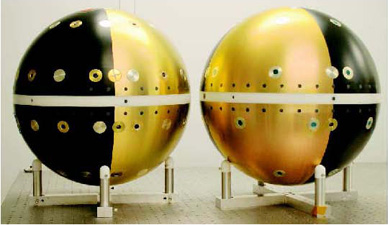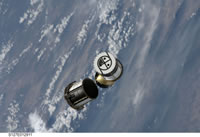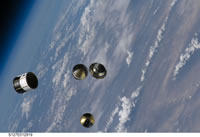
ANDE
Jump to: Mission Objectives, Mission Instrumentation, Mission Parameters, Additional Information
Mission Photos:
 |
ANDE-2 Spheres CASTOR (left) and POLLUX (right). |
| ANDE Shuttle Deployment photos Courtesy of NASA | ||||
 Pollux and Castor (NASA image ID s127e012938) |
||||
Mission Objectives:
The Atmospheric Neutral Density Experiment (ANDE) flight is a mission flown by the Naval Research Laboratory to monitor the thermospheric neutral density at an altitude of 350km. The mission will be launched from the Space Shuttle in May 2009 and will measure the density and composition of the low Earth orbit atmosphere while being tracked from the ground to better predict the movement and decay of objects in orbit.
The ANDE mission consists of two spherical microsatellites fitted with retroreflectors: ANDE Active spacecraft (Castor) and the ANDE Passive spacecraft (Pollux). The satellites are identical in dimension (diameter of 19 inches), but have different masses, and will be tracked by the ILRS network as well as the Space Surveillance Network (SSN). The spheres will be in a lead-trail 400 km, 51 degree inclination orbit. Because of the difference in mass, the satellites will drift apart over time. The position observations of the satellites will permit studies on spatial and temporal variations in atmospheric drag associated with geomagnetic activity. Scientific objectives include:
- Provide Total Atmospheric Density for Orbit Determination and Collision Avoidance
- Validate Fundamental Theories on the Calculation of the Drag Coefficient
- Provide Calibration Objects for SSN
- Establish a Method to Validate Neutral/Ion Density and Composition Derived from DMSP Sensors
- Space to Ground Optical Communication Experiment
The passive sphere (Pollux) wase observed with SSN and SLR. The variation in the observed position will be used to determine in-track total density. Tracking of the active sphere (Castor) will be used to determine its position with respect to the passive sphere. On-board instrumentation will compute total density and composition.
The last observation of the ANDE Pollux spacecraft was on 28-Mar-2010 at 22:55 from the Beale Phased Array (west coast of CONUS), Shortly after, the spacecraft re-entered the Earth's atmosphere.
ANDE has the following on-board instrumentation and components:
- Active Sphere:
- Retro-Reflector Array
- GPS
- Wind and Temperature Spectrometer (WATS) for measuring ion and neutral winds and temperature
- Thermal Monitoring System (TMS) for monitoring internal and skin temperature
- Miniature Electronic Analyzer (IMESA) for measuring electron density and temperature
- Photovoltaic Arrays
- 3 Gyroscopes and 3 MEMS accelerometers for determination of spin rate and orientation
- Passive Sphere:
- Retro-Reflector Array
- 3 Gyroscopes and 3 MEMS accelerometers for determination of spin rate and orientation
Mission Parameters:
| ANDE Active (Castor) | ANDE Passive (Pollux) | |
| Sponsor: | NRL | NRL |
| Expected Life: | 1 year | 1.5 year |
| Primary Applications: | determine total atmospheric density in orbital plane | determine total atmospheric density in orbital plane |
| Primary SLR Applications: | Precision orbit determination | Precision orbit determination |
| COSPAR ID: | 0903806 | 0903805 |
| SIC Code: | 1073 | 1074 |
| Satellite Catalog (NORAD) Number: | 35694 | 35693 |
| Launch Date: | July 30, 2009 | July 30, 2009 |
| RRA Diameter: | 12.7 mm | 12.7 mm |
| RRA Shape: | sphere | sphere |
| Reflectors: | 30 corner cubes | 30 corner cubes |
| Orbit: | circular, non sun-synchronous | circular, non sun-synchronous |
| Shape: | 19.0 inch diameter sphere | 19.0 inch diameter sphere |
| Inclination: | 51.6 degrees | 51.6 degrees |
| Eccentricity: | 0.0007 | 0.0007 |
| Altitude: | 350 km | 350 km |
| Weight: | 50 kg | 25 kg |
Additional Information:
Web sites:
- NASA
- NASA Space Station Expeditions overview
Publications:
- Atmospheric Neutral Density Experiment (ANDE-2) Flight Hardware Details
- L. Thomas, “ANDE Concept”, 16th International Workshop on Laser Ranging, Poznan Poland, October 2008.








